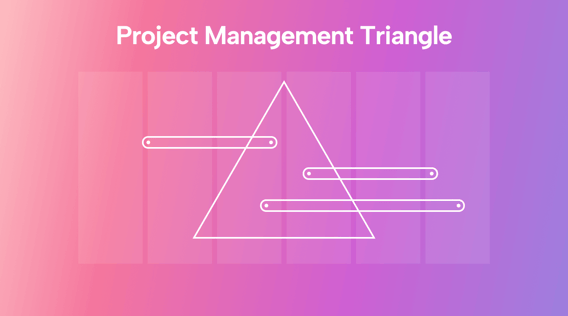Are you struggling to manage your teams better and get your projects moving in the right direction?
The project management triangle, when applied right, can help you make good decisions that lead your projects forward.
But the last thing you need is another jargon-riddled post that doesn’t explain how a project management concept applies to real life.
In this guide, we’ll break down (using normal English and plenty of examples) the project management triangle and show you how it applies to your business. Then we’ll share a few ideas for how you can use the PM triangle to manage your projects more effectively.
What is the project management triangle?
The project management triangle is a model that illustrates how closely connected the factors of cost, time, and scope are in a project.
It’s usually shown as a simple triangle, each representing one of the three project constraints: scope, cost, and time.
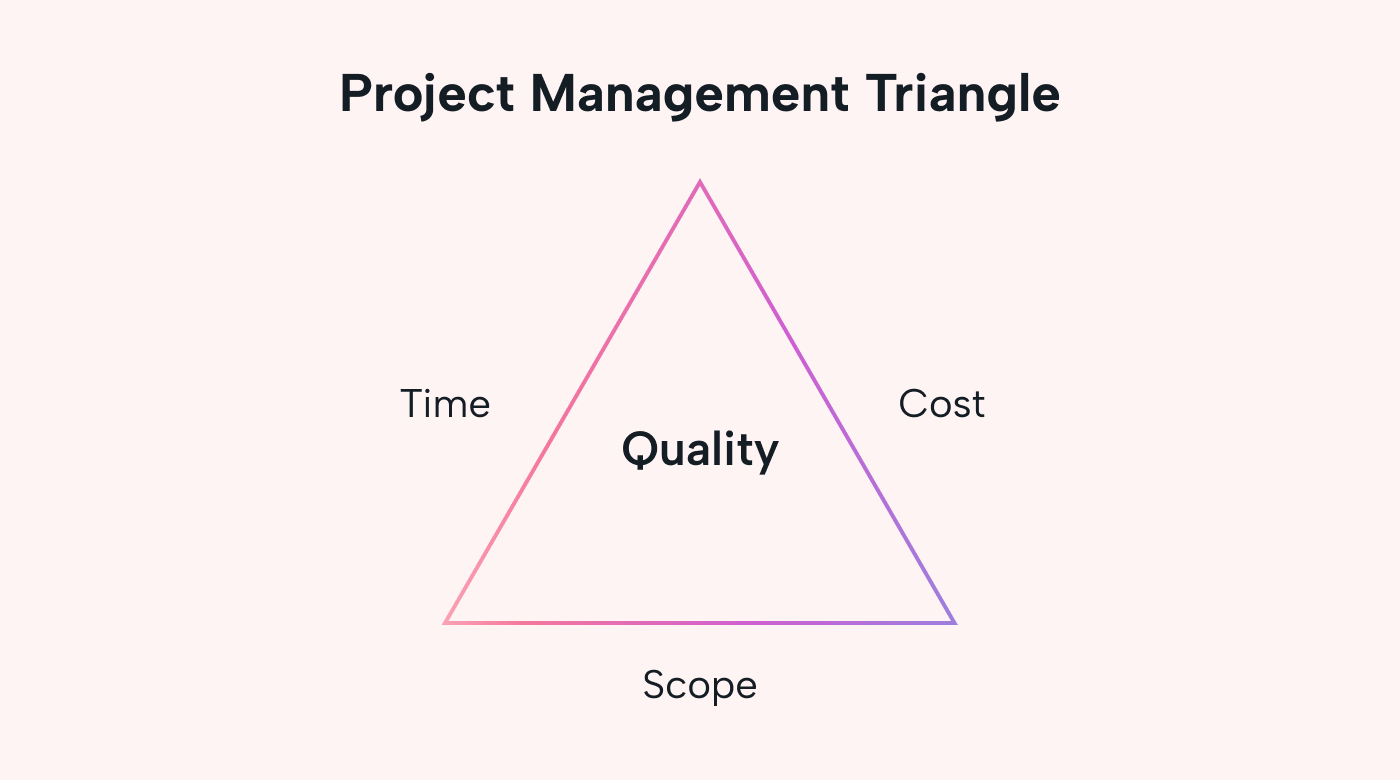 |
It’s a crucial concept in traditional project management, AKA the waterfall project management methodology. That’s where you plan a project from start to finish, starting with your goals and project requirements.
Since you begin with a clearly defined idea of the project scope, timeline, and budget, it’s often called the “iron triangle.” The idea is that if you change the scope, your estimates for time and expenses also have to change (and vice versa).
If you change the goalpost from creating a new feature to developing a new iOS app, you must increase your timeline and budget. When planning this way, the three factors are interconnected constraints, not mere considerations. Hence, the iron triangle. That’s also why many project managers call it the “triple constraint.”
With a more modern Agile approach to project management — where you start the project with limited planning and let the progress and roadblocks guide you in real-time — this notion, and the triangle, is typically turned on its head. We’ll cover that in more depth later.
First, let’s explore the components of the project management triangle and how you should think about it when planning projects.
The 3 constraints of the iron triangle and how they affect each other in real projects
You’ve already seen a simplified example, but let’s take some time to dive into the logic behind the iron triangle and how the project constraints affect each other.
Scope constraints
Most companies start a project with a fairly clear goal for their project. For example:
- You want to redesign the company website.
- You want to hire three new sales reps (that are good at their job).
- You want to renovate your office to make it look better.
Suppose you have a non-negotiable goal that leads to iron-clad scope restraints. If you’re trying to hire the three best B2B sales reps in your state, you can’t expect to do so in a few days, with no investment in job advertising, while offering a bare-bones salary.
Your company must invest the time and money needed to finish a project of that scope.
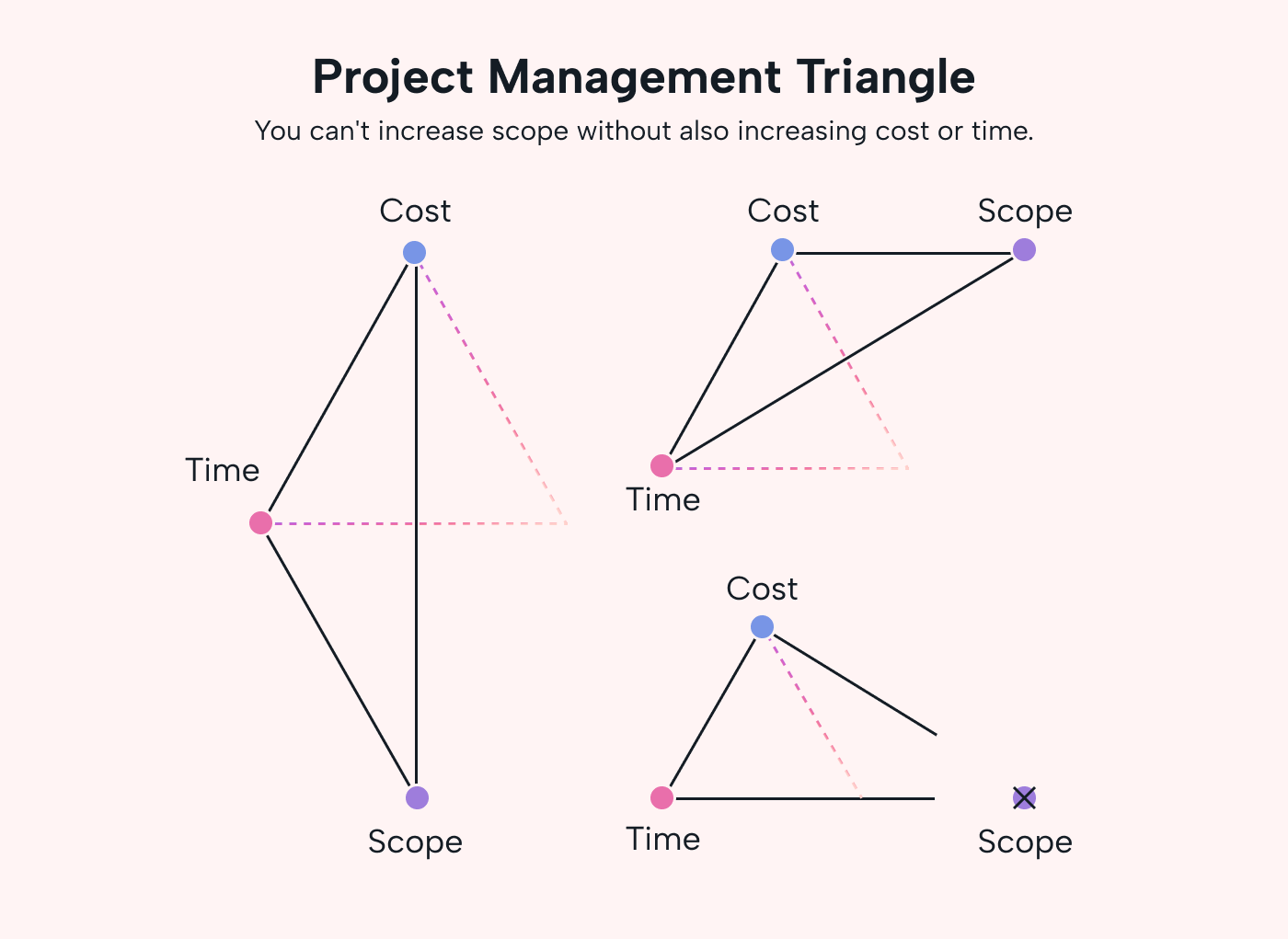 |
That’s an example of a “scope constraint,” when the goals you want to achieve with your project affect how much time and money you have to spend on a project.
But the whole idea of the iron triangle is that this is anything but a one-way street. Scope affects the timeline and budget, sure. But it also works the other way around.
Cost constraints
Unless you’re Midas, you can’t afford to spend unlimited resources on your projects. That means you’ve got to make concessions.
That’s what cost constraints are. Your available resources decide how ambitious you can be.
Sure, you’d like to hire Jony Ive (designer of the iPod and iMac) to design a groundbreaking new speaker. But you don’t have the eight-figure budget to hire him. Instead, you settle for assembling a design team that uses existing customer feedback to improve your best-selling Bluetooth speaker.
The thing is, it’s hard to predict how much money something will cost at the start of a project. Nobody can reliably estimate direct project costs before even kicking off the project.
You also have to deal with indirect project costs (administrative costs, increased utility bills, etc.). Because it’s hard to foresee these at the start of the project, they’re also sometimes called hidden project costs.
Usually, you realize halfway through a project that you either need to increase the budget or drastically reduce the scope of your project.
These project budgeting issues are anything but rare. A 2022 survey by KPMG showed that only 36% of projects finished within their budget.
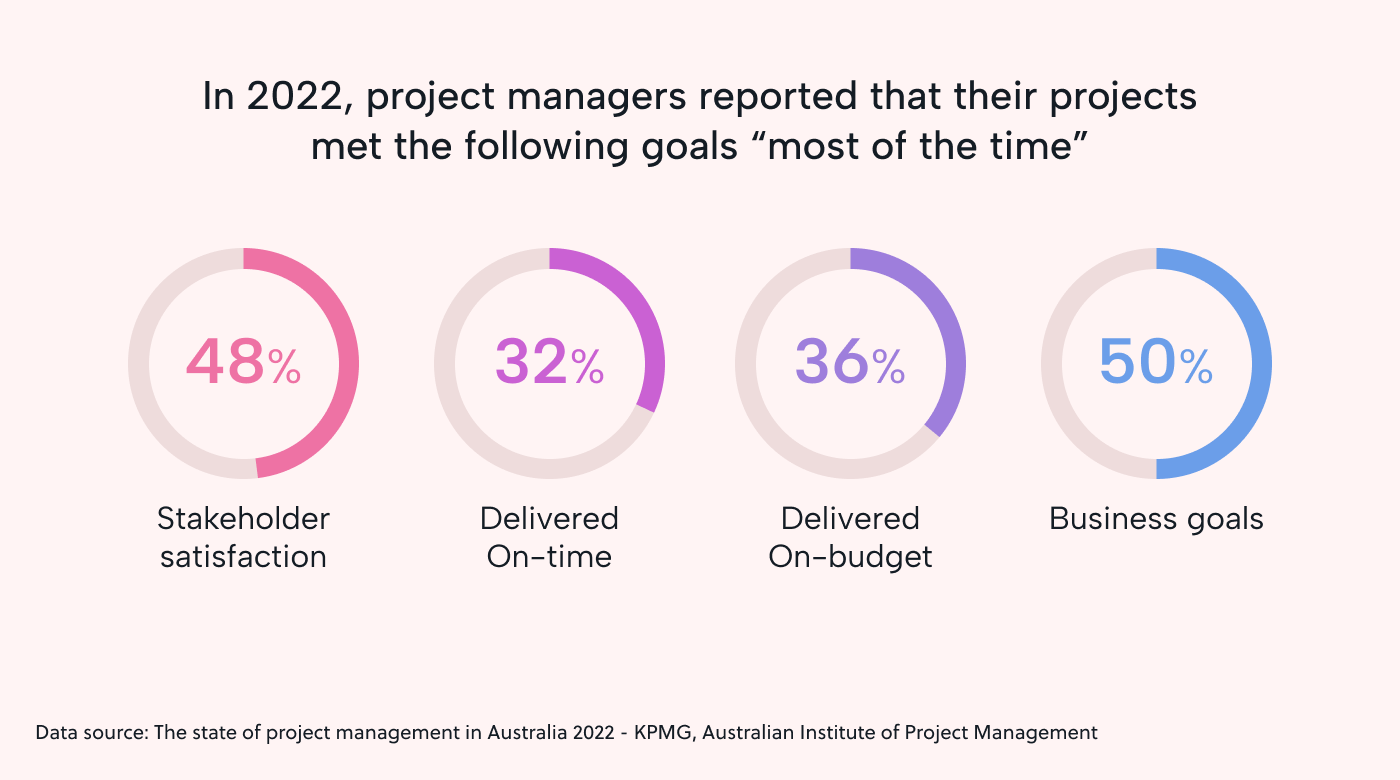 |
So take budgeting seriously when mapping out your project and considering its scope.
Time constraints
Time constraints make up the final part of the traditional project triangle.
When do you need to reach the finish line?
If you have a concrete deadline, this will affect how ambitious your scope can be. For example, let’s say you want to renovate your school office. The problem is, you have to re-open the new office in two months, after a summer break. That means a complete renovation is likely out of the question.
But again, when you’re creating a work breakdown structure (a rundown of tasks and your project schedule), how do you know how long a task will take? Experience and good research can help you make educated guesses, but they’re not facts.
Even experienced project managers get it wrong. And as we saw above, only 31% of project managers said they finished projects on time “most of the time.”
Proper time management can help your project team meet important milestones and deadlines, but only up to a point. If your expectations are completely wrong, no amount of efficiency can help you finish on time.
The 3 keys to mastering the triple constraint
To sum up the difficulty of the project triangle in a sentence, your expectations will never reflect reality. The triple constraint guarantees that any misjudgments in one area also affect the other.
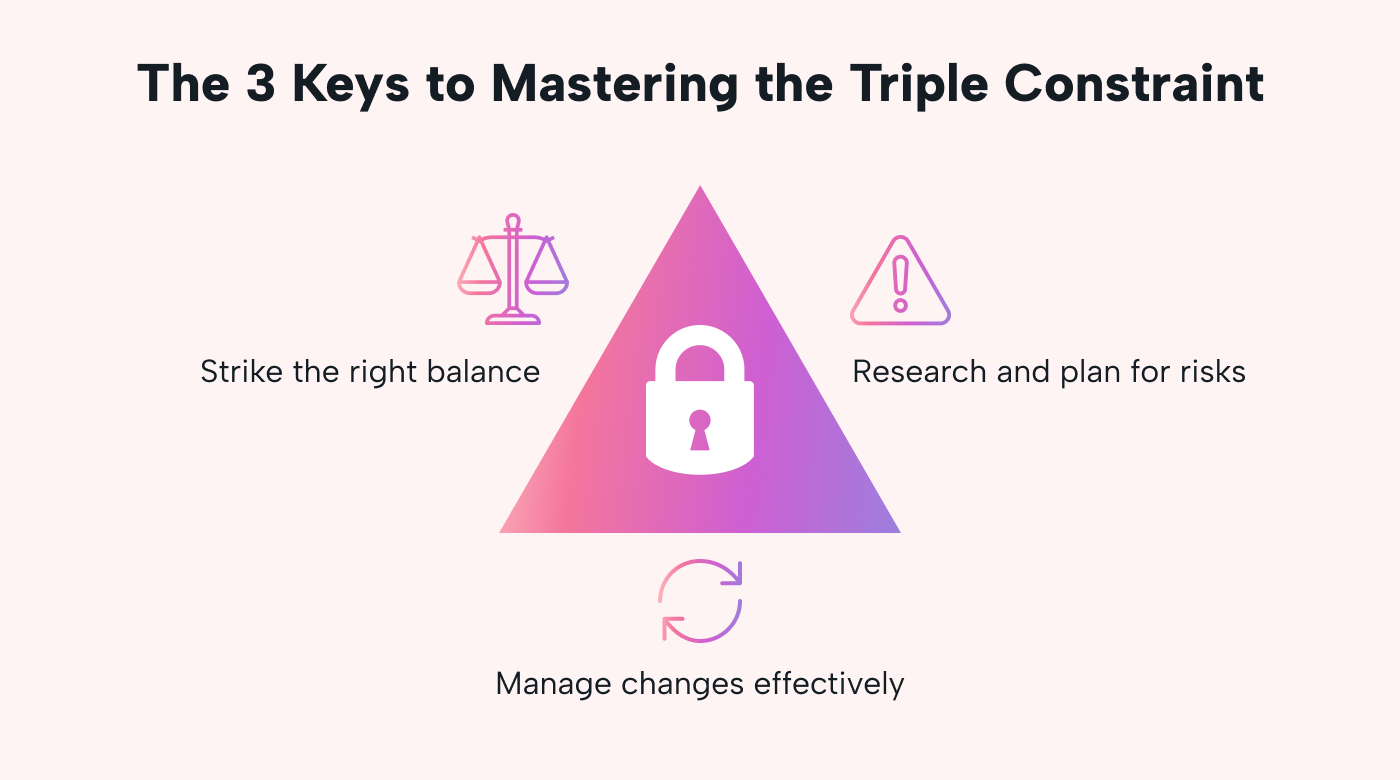 |
Strike the right balance
If your project scope isn’t negotiable, you’ll have to adjust your budget and project schedule accordingly. If your timeline or budget is set in stone, you may have to adjust your project scope to finish on time or within budget.
That’s what the triple constraint illustrates. The key to getting the best result every time is to strike the right balance.
Figure out your must-have project requirements, nice-to-haves, absolute max budget and timeline, and work from there.
This balance looks completely different for each project. The construction of the International Space Station went billions of dollars over budget and went years beyond its schedule.
But rushing it or spending less on development would have meant neglecting crucial project requirements, like ensuring the safety of the astronauts.
Luckily, most projects are less rigid in terms of requirements and project scope (and way less ambitious).
If you’re renovating your office, you can downgrade from designer chairs to cheaper ergonomic ones while still meeting the main goal of creating a better workspace for your staff.
Do your research and manage risks
Poor research has stopped plenty of projects in their tracks. Before you start a project and decide on a budget and project schedule, you need to understand all the factors at play.
For example, let’s say you want to attract more recent graduates for entry-level positions with an internship program. First, you need to figure out the requirements:
- Look at what competitors are already doing (career events, fliers, seminars, etc.).
- Brainstorm concrete tasks you need to attract applications, interview, and hire interns.
- Consider how tasks are dependent (you can’t put up a job ad without having a plan to handle interviews).
- Break the project down into a cohesive chain of tasks (the critical path).
A realistic image of what is required and an understanding of how different tasks depend on each other is crucial for planning a realistic project schedule and budget.
But things don’t always go according to plan. Project risks can dramatically affect your project costs or schedule or even lead to complete failure. So, carefully consider what can go wrong and adjust accordingly. For example:
- Career events could get canceled due to weather — promote on social media.
- Selected interns could cancel — stay in touch with viable candidates.
Don’t get caught unprepared.
Manage changes effectively
For long-term projects, something that will dramatically change your plans is almost guaranteed to pop up.
Even with good research and risk management, you just can’t foresee some things.
How many events got canceled in 2020 because of Covid? Too many. But a few managed to pivot and go virtual, cutting their losses and standing out in their industry.
The traditional way to do this is by outlining a clear change management plan. In it, you identify the need for changes and the scope, budget, and tasks required to make the adjustment.
If this all seems like a bit much for the size and scope of the projects you typically tackle, a more Agile approach may be a better choice.
Turning the project management triangle upside down with Agile project management
Agile project management is an iterative approach emphasizing flexibility and speed. You don’t go into a project with a complete project plan, schedule, and budget. You don’t have a five-page-long flowchart of all dependent tasks mapped out.
Instead, you have an overarching goal, like improving your product or creating a new feature, and let your project team (more or less) manage themselves.
This approach naturally leads to a flipping of the project management triangle. You don’t start with project requirements. Instead, you start by considering your available resources and set realistic short-term goals from there.
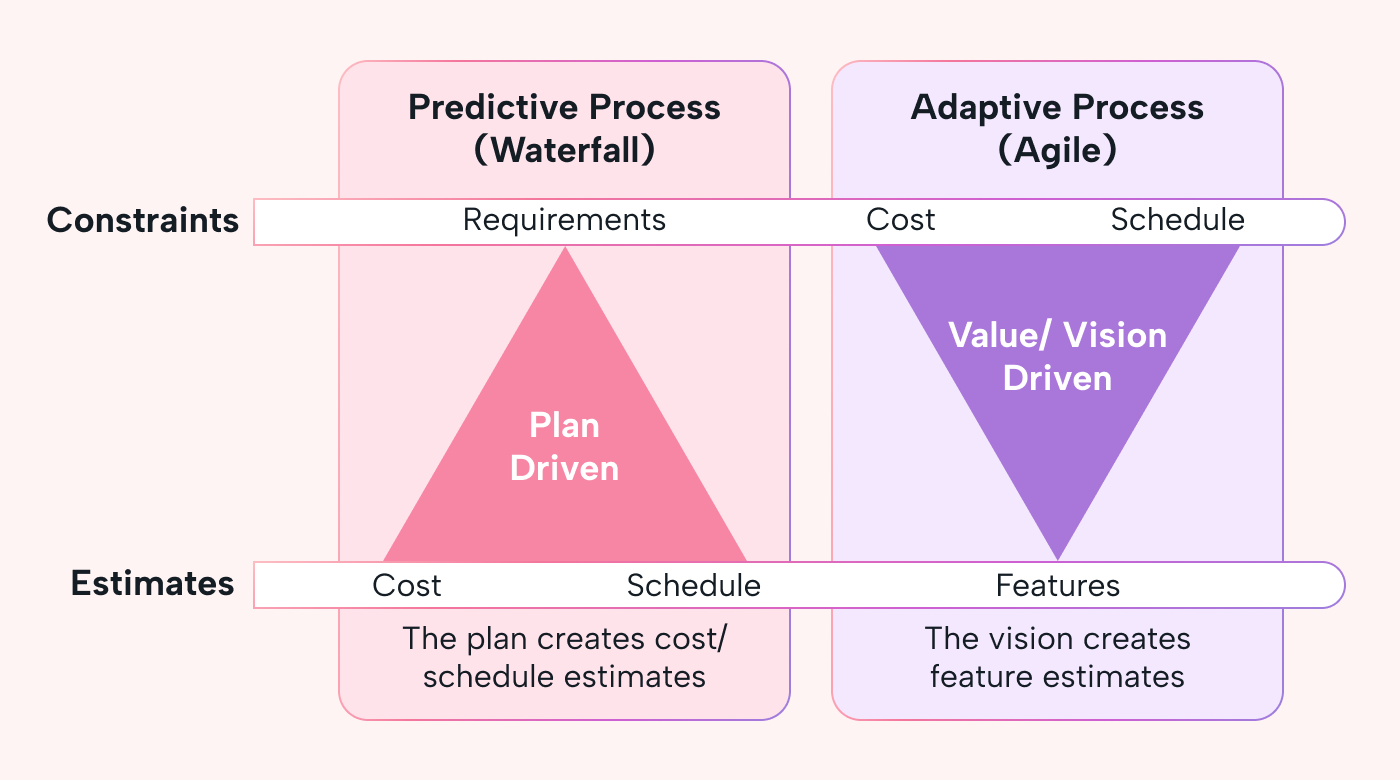 |
The Agile triangle emphasizes delivering value to your customers as soon as possible. Instead of waiting for all features to be completed, you typically release more frequent “versions.”
Because of the shorter time frame and the focus on meeting customer needs, products developed this way often align more with what your customer wants (especially digital ones).
For these reasons, Agile has already completely taken over the software development industry. (In a survey of software professionals in 2021, 94% said they had at least spent some time using Agile.)
But the methodology is compatible with a much broader range of industries and types of projects. From designing and landscaping a large garden to manufacturing innovative consumer products, Agile principles can help your team finish projects faster.
By not setting clear requirements at the get-go, you don’t have to prioritize must-have features at the beginning. The project team will discover them by working in close collaboration with stakeholders. As a result, people with a vested interest in the project, like potential customers or internal users, will guide the project forward.
In other words, Agile’s iterative process means you’re constantly rebalancing the project triangle, inching ever closer to the ideal project execution.
But if you have very clear project requirements and closely dependent tasks that you cannot compromise on, like in a construction project, Agile isn’t a good fit. You have to consider your project, goals, constraints, and resources before deciding which way to go.
How Motion can help you deal with time constraints
Whether you’re into Agile or follow the iron triangle and the PMBOK religiously, we can all agree that deadlines are easier to set than to keep.
- Poor communication can lead to delays.
- One delayed task can affect when another can start.
- Before you know it, the project schedule gets pushed back.
At Motion, we understand that many projects often exist across teams and between the day-to-day processes that keep your company running. It’s often hard for your team members to prioritize and plan when to work on what.
 |
Motion takes out the stress and guesswork of time management. With Motion for Teams, you can set priorities, dependencies, and deadlines for tasks and let Motion automatically assign the tasks to your team member’s calendars.
And unlike many project management tools, it’s actually easy to get started with.
Try Motion today, and take back control over your project schedules. Use our free 7-day trial to see exactly how much Motion can speed up your project progress.

